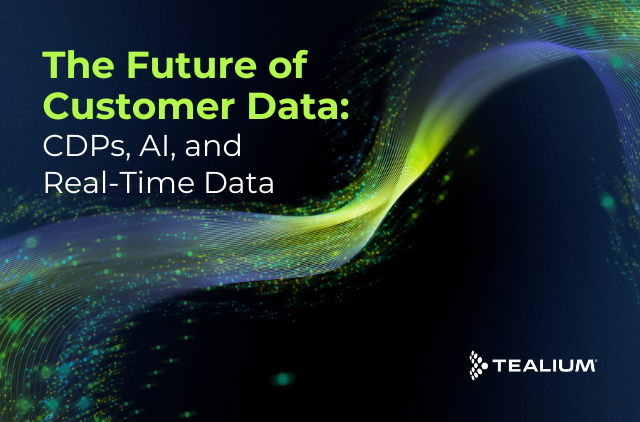[rt_reading_time label=”Reading Time:” postfix=”minutes” postfix_singular=”minute” padding_vertical=”4″]
In the last twenty years, data maturity has become increasingly important to enterprise and small businesses alike. How a company manages their data and empowers their customers and employees with that data can help determine long-term success. That’s why we’re kicking off a four-part webinar series around enterprise data maturity with our first installment, “Customer Data Maturity Powers the Modern Enterprise.”
Data Maturity and the Rise of the CDO
With more companies looking to become more data mature, the role of the Chief Data Officer (CDO) has become increasingly common and important. CIO defines the Chief Data Officers as the role which “oversees a range of data-related functions that may include data management, ensuring data quality and creating data strategy. He or she may also be responsible for data analytics and business intelligence, the process of drawing valuable insights from data.”
According to CIO, the first CDO was appointed by Capital One in 2002, but as of last year, 62.5 percent of Fortune 1000 companies had a CDO in place. That number sounds low, given how strategically important the role is in tying together data and business goals. Other related titles like Chief Analytics Officer or Chief Digital Officer may be the ones taking on the Chief Data Officer role, depending on the organization’s structure.
Whatever you call it, the executive and teams responsible for turning data into actionable insights is an increasingly important role and will play the biggest role in determining the data maturity of the entire company. Customer data, in particular, is shared by and impacts the day-to-day operations and strategic goals of marketing, sales, customer success, and account managers.
But with hundreds of technologies making up those day-to-day operations for each of those departments, the CDO faces a huge hurdle to reaching a mature data strategy: silos of data. As a result, many companies are still trying to figure out exactly what data they have and where it’s stored— and they’re not going to be able to skip straight to data and analytics that can drive conversations around profits and losses or machine learning initiatives.
Data maturity is possible for companies with the right strategy in place. Our recent commissioned research with Forrester Consulting, entitled “Customer Data Maturity Powers the Modern Enterprise,” highlights what it takes for companies to achieve the level of data maturity they need to keep up with the advancement of today’s data technologies and strategies.
Matt Parisi, our Senior Manager of Product Marketing, is breaking down the report for you in a four-part webinar series. In the first installment, Matt walks you through the key takeaways of the Forrester research report. You can watch the webinar by clicking on the image below, or keep reading to get the highlights.
Data Maturity Study Shows Growing Up Is Tough
The concept of data maturity has been around for a long time, but as it becomes more impactful on day-to-day business operations and strategic business goals, the fundamentals are being explored more rigorously than ever before.
Principal Conclusions of the Customer Data Maturity Study [1:22]
- Six Dimensions of Maturity [1:33]
The report found that there are six critical pillars to creating mature customer data management. Focusing on just one aspect— the technology or the strategy, for example— will slow down the journey to data maturity.
At the start of the webinar, Matt provides a high-level overview of each of the six independent categories required for a mature customer data organization.
a. Strategy
How is the strategy applied? And how committed is your company’s culture to maximizing data use?
b. Organizational Structure
What skills are available to your organization? How is the team structured?
c. Data Management
How broad and deep are your data sources? How (or is) data prepared for use? How sophisticated is data management across the tech stack?
d. Analytics and Measurement Capabilities
What methodology is used to measure? What statistics are produced?
e. Processes
How do insights flow across the organization? How are insights prioritized? How is analysis output executed? How are insights shared?
f. Technology
How is technology being used to integrate data? How are activations taking place?
- Customer Data Integration is Key [6:34]
Another takeaway from the report was that “84%, on average, report that key business objectives are ‘well supported’ by their customer data strategies.” This conclusion is probably not surprising to anyone who has been paying attention to the data landscape, as customer data platforms have been the hottest topic over the last year.
- High Maturity Organizations Do Even Better [7:34]
Unsurprisingly, the report found that data mature organizations understand their customers better, are more productive and get a better lift from their customer propensity models than data immature companies.
Study Methodology [9:12]
The research, which surveyed 330 decision-makers at companies across the globe – including the US, UK, France, Germany, and Japan – looked at businesses’ approach to using customer data to drive customer satisfaction, increase revenue, implement better data governance, and improve profitability.
The roles that were surveyed included customer analytics, advertising/ marketing, customer experience, IT, and line of business product teams. And those roles came from a diverse set of industries, including digital services, financial services and insurance, travel and hospitality, retail, healthcare, and media.
In spite of the diversity of roles, each one of them played some part in the customer data strategy at their organizations.
Deep Dive into the Data [11:35]
The study ran from July 2018 through January 2019 and found that, overall, there were four levels of data maturity: Pioneers, Leaders, Followers, and Laggards.
The high-scoring Pioneers are the most advanced in their use of customer data, with the ability to leverage it in real-time across their entire tech stack. Leaders, who scored right behind Pioneers, are activating data across the entire customer lifecycle, instead of just at the campaign level. Followers are able to analyze customer data and support multichannel programs that drive customer acquisition and retention. Lastly, Laggards are early on in the data maturity process, with the ability to segment audiences for outbound communications.
Taking a holistic look at the data, here’s how organizations ranked across the six dimensions of data maturity:
- Pioneers (16%)
- Leaders (35%)
- Followers (33%)
- Laggards (16%)
While most of the responding organizations fall in the Leaders and Followers categories, the capabilities gap between the Pioneers and the Laggards can be quite large. Matt walks you through each of the six dimensions of maturity to show you where organizations are excelling and where they’re falling behind.
According to the research, companies are most likely to struggle with data strategy and technology, specifically applying strategy and activation through technology. In the webinar, Matt breaks down exactly what it means to excel or struggle in each of the six dimensions of data maturity.
One of the most interesting discoveries, according to Matt, is that data maturity does not necessarily mean your data strategy has been in place longer. In fact, it’s the opposite. A surprising 69% of Laggards have a customer data strategy over two years old. Newer data strategies, favored by Pioneers, are needed to adapt to the changing customer data technology landscape.
Recommendations and Next Steps [26:31]
Data maturity is a complex web of people, strategies, and technologies. As you’re working to improve your organization’s customer data maturity level, there are five things you need to do to start.
- Assess your current capabilities honestly.
- Recognize the benefits of integrated customer intelligence to help remove the silos between customer-oriented technologies and channels.
- Seek solutions whose flexibility matches your current data realities.
- Understand that data maturity requires optimizations over time.
- Establish a Center of Excellence for a cross-departmental approach to customer data strategies.
Laggards aren’t going to go become Pioneers overnight. But by starting the conversation now, your company can move towards a higher level of maturity before the competition leaves you behind.
Start the conversation in your organization when you check out and share the webinar “How Customer Data Maturity Powers the Modern Enterprise” today!








